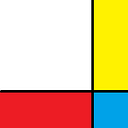Fra Angelico: The Pilgrim Artist
在宗教艺术鼎盛之时,王公贵族将无数金钱、珍宝放到教会手中,打造耀眼的法衣,搭建极尽奢华的祭坛,绘制涂满珍稀颜料的画作。如此,他们就可以获得一条用金钱打造出的救赎之路。就在这样一个的浮躁的时代,有一位画家,一生谦卑且真诚,用一颗温柔、沉静之心向上帝证明他的虔诚,告诉所有人信仰与金钱和地位无关,上帝在每个人身边。他就是圭多·迪·彼得(Guido di Pietro),人们称他为安吉利科修士(Fra Angelico),意为“天使修士”。
At the height of religious art, the aristocracy put countless money and treasures into the hands of the church, created dazzling vestments, built extremely luxurious altars, and painted paintings coated with rare paints. In this way, they can get a way of redemption created with money. In such an impetuous era, there was a painter who was sincere throughout his life, proving to God with a humble heart, that all people have nothing to do with money and status. He was Guido di Pietro, and he was called Fra Angelico, meaning “angel monk”.
安吉利科修士最著名的作品是《圣母领报》,针对这一主题,他创作过一系列作品:
Fra Angelico’s most famous work is the “Notre Dame”, for which he has created a series of works:
画面中,天使加百列向圣母玛利亚告知她将受圣神降孕而诞下圣子耶稣。画面中天使双手抱在胸前 — — 承诺上帝之怀抱,圣母坐在座椅上,膝盖上有一本打开的书,目光顺从且坚定。
In the picture, the angel Gabriel informs the Virgin Mary that she will conceive with the Holy Spirit and give birth to the Son Jesus. In the picture, the angel holds his hands on his chest — a promise of the embrace of God. The Virgin is sitting on the seat with an open book on her knees, her eyes obedient and firm.
这副作品的特别之处在于圣母和天使进行了一场对话,天使之语写作两行,从左至右阅读,圣母之语写在两行之间,并且是上下颠倒的。观众需倒立,从右至左阅读,这象征着圣母之语是写给上帝的。
What is special about this work is the dialogue between the Virgin and the Angel. The words of the angel are written in two lines, read from left to right, the words of the Virgin are written between the two lines, and are upside down. The audience needs to stand upside down and read from right to left, which means that the word of the Virgin is written to God.
这幅作品的独特之处在于画面左上方讲述的是因偷吃禁果而被赶出伊甸园的亚当与夏娃。圣灵(鸽子)之光从他们头顶越过,指向圣母,将“始祖堕落”和“圣母领报”联系在了一起。再加上花园中的红玫瑰(象征激情之罪)和左上角的手掌(象征基督未来之难),预示着“耶稣基督降临人间就是为了舍己受死献身赎罪”。
The unique feature of this work is that Adam and Eve were driven out of the Garden of Eden for stealing the forbidden fruit. The light of the Holy Spirit (the dove) crossed over their heads and pointed to the Virgin, linking “The Fall of the First Patriarch” and the “Notre Dame”. Coupled with the red rose in the garden (symbol of passion) and the palm in the upper left corner (symbol of Christ’s future trouble), it foretold that “Jesus Christ came to earth to lay down his sins for the sake of self-denial and death.”
这副作品也是安吉利科修士三幅圣母领报祭坛画的第三幅,其余两幅作品中也有“始祖堕落”的影子,但位置较为隐蔽。
This work is also the third painting of the three altar paintings of Brotherhood of the Virgin by Fra Angelico. The remaining two works also have the shadow of “the ancestor’s fall”, but the location is more hidden.
此外,安吉利科修士还以此为主题,创作过湿壁画:
In addition, Fra Angelico also used this theme to create wet frescoes:
这两幅作品依然有着哥特式绘画风格的影子,人物消瘦、单薄,但他选用了明亮柔和的色彩,构图合理简单,再加上他对透视技法的熟练运用,整个画面透露出平和安静,充满朴实之美。
These two works still have the shadow of Gothic painting style, the characters are thin and thin, but he chose bright and soft colors, the composition is reasonable and simple, and his skillful use of perspective techniques, the whole picture reveals peace and quiet Full of earthy beauty.
对于安吉利科修士来说,绘画就是他的修行。他的所有作品都以宗教为题材,颜色简朴明快,画面平静温柔。他用自己的虔诚和真诚在画坛留下了重重一笔,影响了米开朗基罗、伦勃朗、埃尔格列柯等一系列画家。
For Fra Angelico, painting is his practice. All his works are based on religion, with simple and bright colors and calm and gentle pictures. With his piety and sincerity, he left a lot in the art circle, affecting a series of artists such as Michelangelo, Rembrandt, El Greco.
